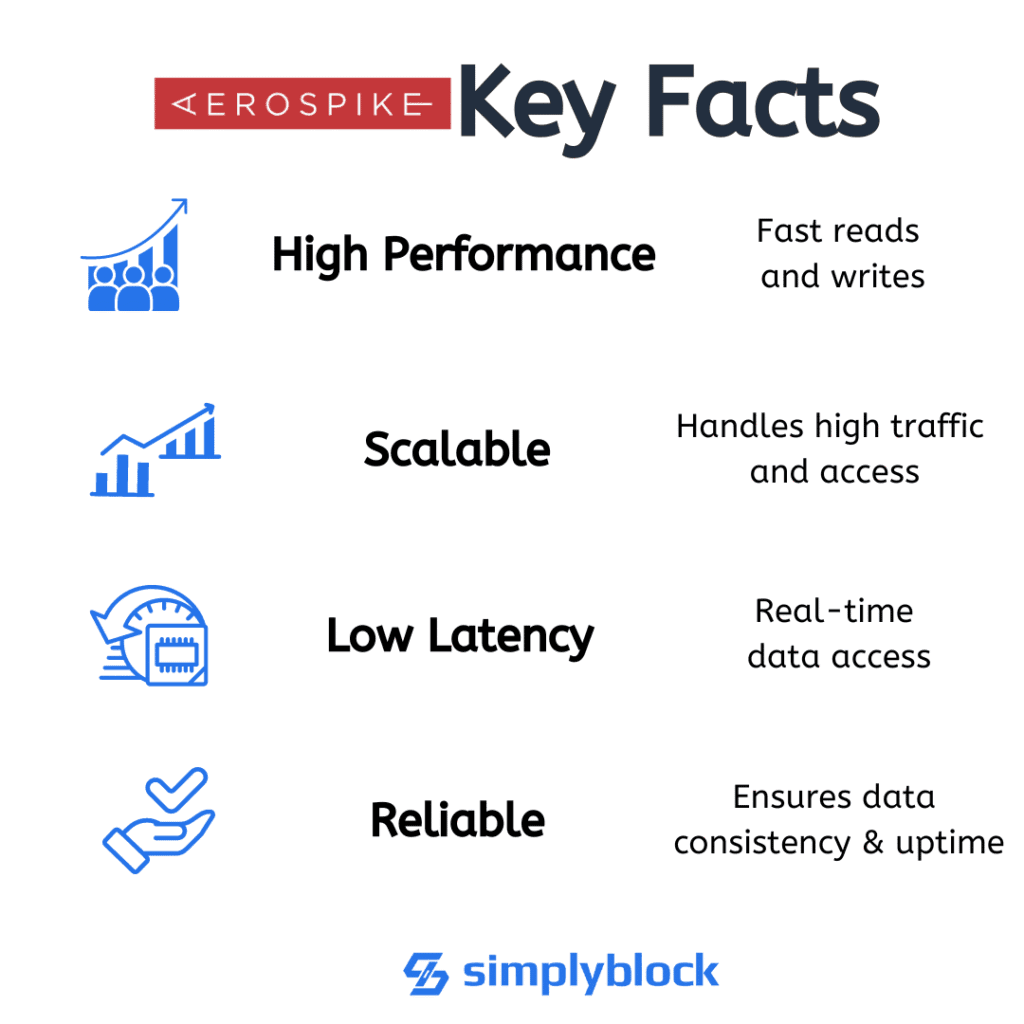Aerospike
Terms related to simplyblock
High-Performance NoSQL for Real-Time Workloads
Aerospike is a distributed NoSQL database platform designed for ultra-low latency, high-throughput operations across hybrid, cloud, or on-premises environments. Built to handle real-time analytics and transactional processing at scale, Aerospike employs a key-value store architecture and is often selected for performance-critical use cases such as fraud detection, recommendation engines, and user profile management in industries like ad tech, finance, and telecommunications.
The system is engineered to utilize solid-state drives (SSDs) efficiently and supports persistent memory, RAM, and NVMe storage, making it highly compatible with NVMe over Fabrics (NVMe-oF)-based backends and software-defined storage layers.
How Aerospike Works
Aerospike employs a hybrid memory architecture. Indexes are kept in DRAM, while data resides on persistent storage. This separation optimizes performance and allows for predictable latency. The platform supports strong consistency, data replication, and cross-datacenter synchronization, all orchestrated by its intelligent cluster management subsystem.
Aerospike supports multi-model data with document, key-value, and graph structures. Its query engine uses secondary indexes and supports filtering and aggregation, though it’s best known for its blazing-fast key-value access patterns.

Aerospike and NVMe-Based Infrastructure
The growing adoption of NVMe storage and NVMe/TCP makes Aerospike particularly attractive. It can directly exploit low-latency block storage over Ethernet without RDMA, making it suitable for disaggregated storage environments.
Deploying Aerospike on a high-throughput unified storage platform like simplyblock allows enterprises to achieve millisecond latency targets without overprovisioning or relying on legacy SAN alternatives.
Aerospike vs Other NoSQL Databases
Below is a comparison to clarify how Aerospike stands against other popular NoSQL systems:
| Feature | Aerospike | Cassandra | Redis | MongoDB |
|---|---|---|---|---|
| Storage Engine | SSD-optimized key-value | Log-structured merge-trees | In-memory, optional disk | Document-based |
| Performance (Latency) | Sub-millisecond | 5–20 ms | Microseconds (in-memory) | Milliseconds |
| Persistence Model | Hybrid memory (DRAM+SSD) | Disk-based | Optional | Disk-based |
| Distributed Architecture | Yes | Yes | Yes (Redis Cluster) | Yes |
| Multi-Model Support | Yes | No | No | Yes |
| Ideal Use Case | High-speed transactions | Time-series, analytics | Caching | General-purpose |
Aerospike’s primary strength lies in high-scale operational scenarios that require consistent low latency, especially when deployed over next-gen infrastructure such as NVMe/TCP-enabled storage backends.
Deployment in Kubernetes and Cloud-Native Environments
Aerospike supports containerized deployment and is compatible with orchestration platforms like Kubernetes. Through CSI drivers and StatefulSets, it integrates well with Kubernetes storage, particularly when paired with storage backends like simplyblock™ that deliver consistent IOPS and throughput.
For operators running Amazon EKS or OpenShift, Aerospike’s performance benefits are amplified when backed by NVMe-TCP block storage systems, enabling rapid deployment of mission-critical microservices.
Use Cases in the Enterprise
Aerospike is often used in scenarios where speed and scale cannot be compromised:
- Fraud prevention systems in banking
- Real-time bidding in advertising technology
- Session and profile stores in e-commerce
- Machine learning feature stores
- Telecom customer data platforms (CDPs)
Its horizontal scalability and ability to handle billions of transactions per day make it a foundational component in digital business architectures.
Benefits When Combined with Simplyblock™
Combining Aerospike with simplyblock provides a robust data layer capable of delivering:
- Sub-millisecond latency over NVMe/TCP
- Strong performance consistency via advanced erasure coding
- Secure multi-tenant workloads through multi-tenancy and QoS
- Flexible deployments in hybrid or edge settings like air-gapped infrastructure
By leveraging simplyblock’s MAUS (Modular, Adaptive, Unified, Shared-everything) architecture, Aerospike can scale across geographies while ensuring compliance, performance, and cost-efficiency.
External Resources
- Aerospike Official Documentation
- Wikipedia: Aerospike Database
- NoSQL Comparison Guide
- Kubernetes CSI Documentation
- Benchmarking NVMe Performance
Questions and Answers
Aerospike is used for ultra-fast, real-time data processing in industries like ad tech, fraud prevention, and financial services. It excels at handling high-throughput, low-latency workloads and scales linearly across distributed systems. When paired with NVMe storage, Aerospike delivers exceptional performance for mission-critical applications.
Using NVMe over TCP enhances Aerospike’s performance by reducing storage latency and boosting IOPS. It allows distributed setups to access remote NVMe drives efficiently without specialized hardware, perfect for high-speed transactional systems.
Yes, Aerospike runs well on Kubernetes, especially when paired with CSI-compatible NVMe storage backends. Simplyblock’s Kubernetes integration allows dynamic provisioning of encrypted, persistent volumes optimized for Aerospike’s real-time needs.
Aerospike supports namespaces and role-based access, but full data isolation depends on the underlying storage. Platforms like Simplyblock enhance this with volume-level encryption and multi-tenant storage provisioning using unique keys per volume.
To optimize Aerospike for high availability, combine replication, rack-awareness, and fast storage like NVMe with software-defined storage. This ensures low failover times, persistent volume support, and better SLA adherence across distributed nodes.
